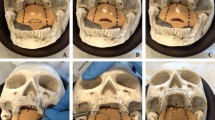Abstract
Introduction
The “Barbed Snore Surgery” is one of the last technical innovations in palatal surgery for Obstructive Sleep Apnea. The availability of a low-cost surgical model able to replicate tissue consistency and main anatomical structures could be fundamental for the spreading of this surgery. The aim of this study was to assess the feasibility of an ex-vivo ovine model in the surgical training of BSS.
Methods
After adequate preparation of adult lamb heads, a post-graduate student with no surgical expertise was guided by a skilled surgeon in the execution of two BSS procedures: “Barbed Roman Blinds Technique” and “Barbed Anterior Pharyngoplasty”. Anatomical limitations and similarity with the human tissue were assessed and recorded during the simulation.
Results
All the procedures were successfully completed. Despite proportional differences, the palatal tissue was assessed as similar in consistency and thickness to the human tissue. The simulation was considered satisfactory and suitable for surgical training.
Conclusion
This ex-vivo ovine surgical model could represent the right tool for BSS training thanks to readily available and inexpensive specimens. Moreover, it appears to present the realistic anatomy and tissue consistence essential for an adequate surgical simulation.


Similar content being viewed by others
References
Javia L, Deutsch ES (2012) A systematic review of simulators in otolaryngology. Otolaryngol Head Neck Surg 147(6):999–1011
Gardner AK, Scott DJ, Hebert JC et al (2015) Gearing up for milestones in surgery: Will simulation play a role? Surgery 158(5):1421–1427
Rinaldi V, Costantino A, Moffa A et al (2019) “Barbed snore surgery” simulator: a low-cost surgical model. Eur Arch Otorhinolaryngol 276(8):2345–2348
Musbahi O, Aydin A, Al Omran Y et al (2017) Current status of simulation in otolaryngology: a systematic review. J Surg Educ 74(2):203–215
Ianacone DC, Gnadt BJ, Isaacson G (2016) Ex vivo ovine model for head and neck surgical simulation. Am J Otolaryngol 37(3):272–278
Ghirelli M, Mattioli F, Federici G et al (2019) Ex vivo porcine larynx model for microlaryngoscopy laryngeal surgery: proposal for a structured surgical training. J Voice S0892–1997(18):30516–30522
Mantovani M, Minetti A, Torretta S et al (2012) The velo-uvulo-pharyngeal lift or “roman blinds” technique for treatment of snoring: a preliminary report. Acta Otorhinolaryngol Ital 32(1):48–53
Mantovani M, Carioli D, Torretta S et al (2017) Barbed snore surgery for concentric collapse at the velum: the Alianza technique. J Craniomaxillofac Surg 45(11):1794–1800
Rinaldi V, Costantino A, Moffa A et al (2019) Postoperative pain and wound healing after coblation-assisted barbed anterior pharyngoplasty (CABAPh): an observational study. Indian J Otolaryngol Head Neck Surg. https://doi.org/10.1007/s12070-018-01577-8
Isaacson G, Ianacone DC, Soliman AMS (2016) Ex vivo ovine model for suspension microlaryngoscopy training. J Laryngol Otol 130(10):939–942
Isaacson G, Ianacone DC, Wolfson MR (2015) Ex vivo ovine model for pediatric flexible endoscopy training. Int J Pediatr Otorhinolaryngol 79(12):2196–2199
Funding
No funding was received for this research.
Author information
Authors and Affiliations
Corresponding author
Ethics declarations
Conflict of interest
All authors certify that they have no affiliations with or involvement in any organization or entity with any financial interest (such as honoraria; educational grants; participation in speakers’ bureaus; membership, employment, consultancies, stock ownership, or other equity interest; and expert testimony or patent-licensing arrangements), or non-financial interest (such as personal or professional relationships, affiliations, knowledge, or beliefs) in the subject matter or materials discussed in this manuscript.
Ethical approval
Because of the nature of this project, no institutional review board approval was necessary.
Informed consent
This article does not contain any studies with human participants or live animal performed by any of the authors.
Additional information
This article is part of the Topical Collection on sleep apnea syndrome. Guest Editors: Manuele Casale, Rinaldi Vittorio.
Publisher's Note
Springer Nature remains neutral with regard to jurisdictional claims in published maps and institutional affiliations.
Electronic supplementary material
Below is the link to the electronic supplementary material.
Supplementary file1 (MP4 263642 kb)
Rights and permissions
About this article
Cite this article
Rinaldi, V., Costantino, A., Moffa, A. et al. Ex-vivo surgical model for “Barbed Snore Surgery”: a feasibility study. Eur Arch Otorhinolaryngol 276, 3539–3542 (2019). https://doi.org/10.1007/s00405-019-05660-w
Received:
Accepted:
Published:
Issue Date:
DOI: https://doi.org/10.1007/s00405-019-05660-w




